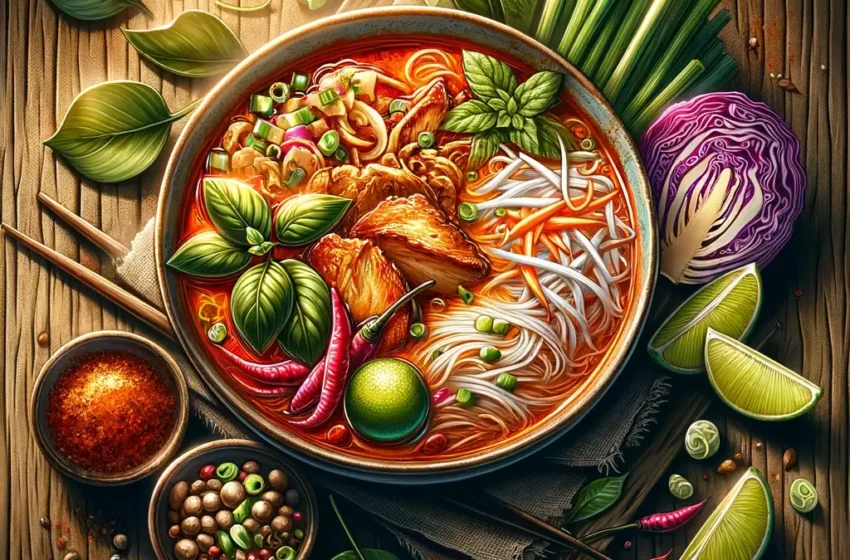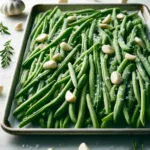As a food reviewer who has had the pleasure of savoring dishes from around the globe, I find myself continually drawn back to the rich, aromatic flavors of Lao cuisine. One dish that stands out in my culinary travels is Khao Poon, a spicy Lao chicken curry noodle soup that offers a delightful blend of coconut milk, fresh herbs, and a unique combination of spices that dance on the palate. This dish is not just a meal; it’s an experience, a journey through the heart of Laos. Today, I’m excited to share with you a detailed step-by-step guide to making Khao Poon, along with pro tips, health benefits, and a conclusion that will leave you eager to start cooking.
Khao Poon Recipe: A Culinary Journey to Laos
- Preparation Time
20 minutes - Cooking Time
30 minutes - Serves
4 Adults - Difficulty
Medium
How to make Khao Poon Recipe
Ingredients
- 1 lb chicken breast or thigh, thinly sliced
- 1 tablespoon vegetable oil
- 4 cups chicken broth
- 1 can (14 oz) coconut milk
- 2 tablespoons red curry paste
- 1 tablespoon fish sauce (adjust to taste)
- 1 teaspoon sugar
- 1/2 teaspoon salt (adjust to taste)
- 2 cups bamboo shoots, sliced
- 1 large carrot, julienned
- 1/2 lb rice vermicelli noodles
- Fresh herbs (cilantro, green onions, mint)
- Bean sprouts, lime wedges, and sliced red chili for garnish
Instructions:- Step by Step
- Step 1: Prepare the Ingredients
- Before diving into cooking, prep your ingredients. Thinly slice the chicken, julienne the carrot, and slice the bamboo shoots. This ensures everything cooks evenly and integrates well into the soup.
- Step 2: Cook the Chicken
- Heat the vegetable oil in a large pot over medium heat. Add the chicken and cook until it’s no longer pink. Remove the chicken from the pot and set aside.
- Step 3: Making the Broth
- In the same pot, add the red curry paste and fry for a minute until fragrant. Pour in the chicken broth and coconut milk, stirring to combine. Add the fish sauce, sugar, and salt. Bring the mixture to a simmer.
- Step 4: Add Vegetables
- Add the bamboo shoots and carrot to the pot. Let them simmer in the broth for about 10 minutes or until they’re tender.
- Step 5: Cook the Noodles
- While the soup simmers, prepare the rice vermicelli noodles according to the package instructions. Usually, this involves soaking in hot water for a few minutes until they’re soft. Drain and set aside.
- Step 6: Combine and Serve
- Return the cooked chicken to the pot and heat through. To serve, place a handful of noodles in a bowl, ladle the hot soup over the noodles, and garnish with fresh herbs, bean sprouts, lime wedges, and sliced chili.
Pro Tips for Khao Poon Recipe :
- For a vegetarian version, substitute chicken with tofu and use vegetable broth instead of chicken broth.
- Adjust the amount of red curry paste according to your spice tolerance.
- Don’t overcook the noodles, as they will continue to soften in the hot broth.
Health Benefits for Khao Poon Recipe:
Khao Poon is not just delicious; it’s also nutritious. Coconut milk is a great source of vitamins and minerals, while the chicken provides high-quality protein. The fresh herbs and vegetables add essential vitamins and antioxidants, making this dish a balanced and healthful choice.
You can also read :- 5 Incredible Recipes
Conclusion:
Khao Poon is a testament to the complexity and richness of Lao cuisine. Its blend of spicy, savory, and sour flavors, combined with the freshness of herbs and vegetables, makes it a dish that’s both comforting and invigorating. Whether you’re a seasoned chef or a curious cook, making Khao Poon at home is a delightful way to explore Lao culinary traditions.
Embarking on the journey to make Khao Poon is not just about feeding the body; it’s about nourishing the soul with the rich tapestry of flavors that define Lao cuisine. Happy cooking!
FAQs on Khao Poon
- What is Khao Poon?
- Khao Poon is a traditional Laotian noodle soup made with a spicy coconut milk broth, chicken, and rice vermicelli noodles, garnished with fresh herbs and vegetables.
- Can I use beef instead of chicken?
- Yes, beef can be used as an alternative to chicken. Adjust the cooking time accordingly to ensure the beef is tender.
- Is Khao Poon gluten-free?
- Yes, when using rice vermicelli noodles and ensuring all other ingredients are gluten-free, Khao Poon can be gluten-free.
- Can I make the broth in advance?
- Absolutely, the broth can be made in advance and stored in the refrigerator for up to 3 days or frozen for longer storage.
- What can I use if I don’t have palm sugar?
- Brown sugar or even honey can be used as alternatives to palm sugar.
- How can I make a vegan version of Khao Poon?
- Use vegetable broth and replace the chicken with tofu or mushrooms for a vegan version.
- What if I don’t have red curry paste?
- You can use yellow or green curry paste as a substitute, though the flavor profile will slightly change.
- Can I add other vegetables to the soup?
- Yes, feel free to add vegetables like bell peppers, carrots, or mushrooms to the broth for added nutrition and flavor.
- How do I store leftovers?
- Store the broth, noodles, and garnishes separately in the refrigerator for up to 3 days.
- Can Khao Poon be frozen?
- The broth can be frozen, but it’s best to prepare the noodles fresh when serving.
- Is it necessary to use kaffir lime leaves?
- While kaffir lime leaves add a unique flavor, lime zest can be used as a substitute.
- Can I use bottled lime juice instead of fresh?
- Fresh lime juice is preferred for the best flavor, but bottled lime juice can be used in a pinch.
- What other proteins can be used in Khao Poon?
- Apart from chicken and beef, you can use fish, shrimp, or even duck.
- How spicy is Khao Poon?
- The spice level can be adjusted according to taste by varying the amount of red curry paste.
- Can I omit the fish sauce?
- Yes, though it adds depth to the flavor, soy sauce or a vegan fish sauce alternative can be used.
- What garnishes are traditional for Khao Poon?
- Traditional garnishes include lime wedges, sliced chili, bean sprouts, cabbage, fresh herbs (cilantro, mint), and chopped green onions.
- Can I use another type of noodle?
- Rice vermicelli noodles are traditional, but other thin noodles could work in a pinch.
- How do I make the soup creamier?
- For a creamier soup, add more coconut milk or a dollop of coconut cream.
- What if I find the soup too spicy?
- Add more coconut milk or a little sugar to balance the spice.
- Can I add more herbs than suggested?
- Yes, feel free to adjust the quantity of herbs according to your taste preferences.
- How do I make the broth more flavorful?
- Simmer the broth for longer and consider adding more fish sauce, curry paste, or herbs.
- What if I don’t have lemongrass?
- Lemongrass adds a unique flavor, but if unavailable, try using lemon zest as a substitute.
- Can I make Khao Poon less creamy?
- Use less coconut milk and more chicken broth for a less creamy broth.
- Is Khao Poon considered a healthy dish?
- Yes, it’s relatively healthy, especially with its lean protein, herbs, and spices offering various health benefits.
- Can I add fruit to Khao Poon?
- While not traditional, some people like to add pineapple or mango for a sweet contrast.
- How do I balance the flavors in Khao Poon?
- Balance is key; adjust the sour, sweet, salty, and spicy elements to your liking.
- Can I make Khao Poon without coconut milk?
- Coconut milk is crucial for the authentic flavor, but you could try a lighter version with more broth.
- What if my soup turns out too salty?
- Add more coconut milk or broth to dilute the saltiness.
- Can Khao Poon be served cold?
- It’s best served hot, but chilled versions can be refreshing, especially in hot weather.
- How important is the fish sauce to the recipe?
- Fish sauce adds a significant depth of flavor, but alternatives can be used to accommodate dietary restrictions.
Sources :-












